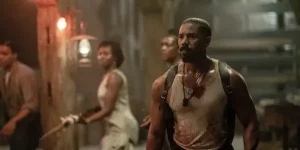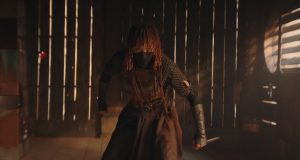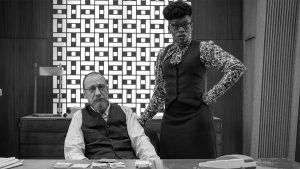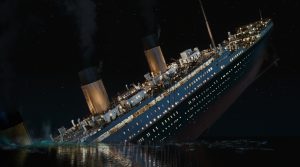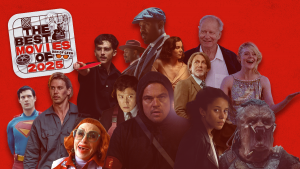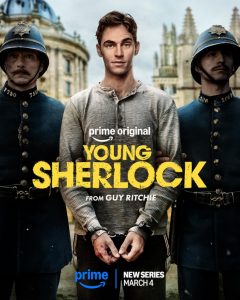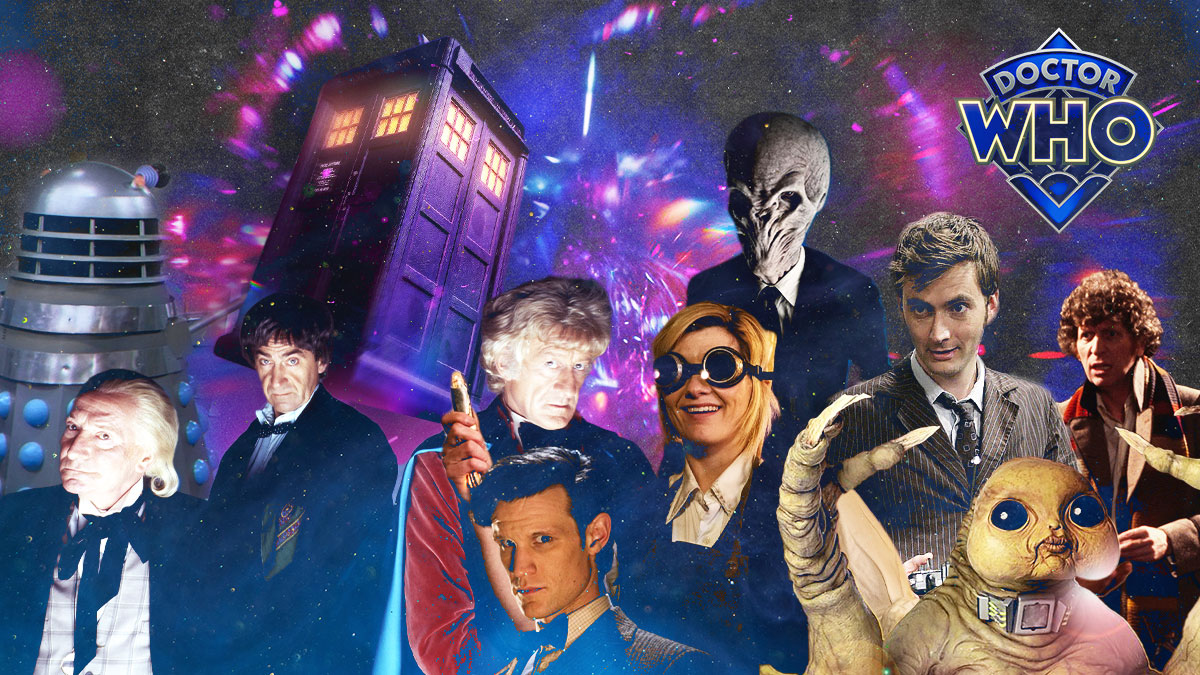
60 years is a long time. For us, if not for the Doctor, who can pass six decades in a single blink and once spent over four billion years trapped inside a coaster. For those of us on Earth though, 60 years is a very long time to have been a part of things, to have been loved and argued about and mourned and revived and then loved and argued about even more.
To celebrate Doctor Who’s miraculous longevity, below are 60 moments from its lifetime that mark it out as something special. Rather than talking about full episodes, stories or seasons, here we’re looking at individual scenes, ideas or images from the show, as well as ephemera surrounding Doctor Who: a cultural moment, a slice of life, a shared experience. This could range from toys to songs to UGNs (Unexpected Graham Nortons).
There are countless to choose from. There are countless perspectives to consider. Your own list will doubtless be different (please share in the comments), but for a show with this much history and scope… isn’t that sort of the point?
1. Barbara Yells at the Doctor (The Edge of Destruction, 1964)
In season one’s ‘The Edge of Destruction’, the Doctor accuses companions Barbara and Ian of sabotage and she has some choice words for him by way of response:
BARBARA: How dare you! Do you realise, you stupid old man, that you’d have died in the Cave of Skulls if Ian hadn’t made fire for you?
DOCTOR: Oh, I
BARBARA: And what about what we went through against the Daleks? Not just for us, but for you and Susan too. And all because you tricked us into going down to the city.
DOCTOR: But I, I
BARBARA: Accuse us? You ought to go down on your hands and knees and thank us. But gratitude’s the last thing you’ll ever have, or any sort of common sense either.
Go off Babs. F**k him up.
2. Doctor Who in an Exciting Adventure With the Daleks (1964)
This was the first Doctor Who novelisation, and one that would be reprinted several times before ultimately being the basis for the Target range of adaptations. Based on Terry Nation’s original Dalek story, this adaptation by script editor David Whitaker makes Ian the point-of-view character and rewrites the beginnings of Doctor Who so that instead of ‘An Unearthly Child’ everyone meets each other after a car crash on a foggy Barnes Common before heading straight to Skaro. Whitaker gives the Daleks a leader too, a glass Dalek with the mutant visible within. The most recent edition of the book, with illustrations by Robert Hack, came out in 2022.
3. London 1965 (The Chase, 1965)
Having actually grown quite fond of each other since the aforementioned bollocking, Ian and Barbara are presented with an opportunity to return to their own time and place, and the Doctor is resistant to them leaving. It’s not clear how much of this is due to genuine danger, or because he simply doesn’t want them to go.
This scene produced a meme (Ian saying ‘London 1965!’) during the Covid Lockdown Twitch streaming, when the show was streamed in its entirety on the platform allowing fans to discover or rediscover the original series.
4. Dr. Who and the Daleks (1965)
Look at the Daleks here, they’re beautiful. This is how popular they were: a book adaptation after a year, and a technicolour movie adaptation of their first story in cinemas around two years after it was broadcast on television. This trailer, clocking in at three minutes long, proves that spoiling the entire film in promotional material is not a recent development. Peter Cushing’s human scientist Dr Who visits the most boldly colourful version of Skaro you’ll ever see, thanks to the inadvertent bum-positioning of popular children’s trumpeter/Norris McWhirter tolerator Roy Castle.
5. Dalekmania (1964 – 1967)
In 1964 the Daleks returned in ‘The Dalek Invasion of Earth’, solidifying their success. ‘The Dalek Book’ by Terry Nation and David Whitaker was published, and would be a key reference point for The Daleks strip in TV Century 21 magazine (the first strip – Genesis of Evil – arrived in January 1965 with an alternate take on the Daleks’ creation, and the whole thing ran until early 1967).
Along with the first of the two Peter Cushing films, 1965 saw the release of the first Dalek toys (notably three models from Louis Marx & Co, including the Dalek Rolykin – small Daleks that fitted nicely in arcade machines, with a ball inside allowing them to glide along smooth surfaces). As well as toy replicas, you could buy bubble bath, ray guns, a nursery toy, slide projectors, board games and playsuits. It was a frenzied period (as seen in the 1967 Sky Ray advert above), that petered out after a few years when the second film performed poorly at the box office and the Daleks retreated from Doctor Who while Terry Nation attempted to launch a spin-off series.
6. The Doctor Faces Down a War Machine (The War Machines, 1966)
There are a lot of endearingly camp moments in this scene, such as the soldiers running away after the War Machine knocks a basket of fruit over, as if their military training didn’t cover dented apples, and the War Machine’s general smashing and exploding of wooden boxes. Nonetheless the clear visual storytelling is what lingers in the mind. In this case it’s highlighted by the Doctor’s tentative steps forward as everyone else retreats. Hartnell’s Doctor was always defiant, and it’s not the only time he does this, but this was the most visually striking.
7. The Cybermen Kill a Horny Italian (The Tenth Planet, 1966)
Here we see two impressive things: the colourised footage of the Cybermen’s first appearance made by a fan, and the Cybermen’s first appearance as they appear from the Antarctic blizzard to kill a terrified sergeant with a well-edited chop to the neck.
The episode reaches its cliffhanger as soldiers Joe and Tito return from the base to help the sergeant, only to meet a similar fate. Tito has what appear to be pictures of scantily clad women on the wall by his bed, and responds to the news that the on-duty guard could see Polly outside by saying “A WOMAN? Hey!” and “Hey, hey! Mamma Mia. Bellissima.”
In case you weren’t sure, Tito is a very nuanced and sensitive depiction of an Italian male.
Anyway, he’s dead. And we see a Cyberman properly for the first time, reaching down to his body and reacting as if it’s remembered what it was like to have warm blood.
8. The First Regeneration (The Tenth Planet, 1966)
This scene is why Doctor Who is still on screen today. For viewers at the time there was some prior knowledge that this was going to happen, but as ever Doctor Who opts to unsettle rather than immediately soothe. The weirdness was continued in the following story, ‘The Power of the Daleks’, where the new Doctor does not immediately reassure viewers that everything’s going to be alright.
In the end though, it was.
9. Bill Hartnell Attends Local Events in Character
From Who’s There? The Life and Career of William Hartnell by Jessica Carney:
…He arrived at the fete, wearing his Doctor Who costume, in an open-topped vintage car. It wasn’t quite the TARDIS (after all you could never guarantee where the TARDIS was going to land), but it was spectacular enough for Pembury, the village in Kent where my parents lived…
Imagine you’re a kid in the Sixties, and there is Doctor Who. Right there. The Wizard of Oz meets Father Christmas.
10. Solidarity with our Aquatic Comrades (The Underwater Menace, 1967)
I haven’t checked, but I’m really confident that no other show in the world has a depiction of fish people going on strike. It’s not the Nineties anymore and we no longer have to pretend that this is a deeply serious show about important things with nothing embarrassing in it whatsoever.
This is Doctor Who… whether you like it or not.
11. ‘Did They Search in Here?’ (The Moonbase, 1967)
The first thing to note is that ‘The Moonbase’ is incredibly silly. The Cybermen’s plan to take over the base and invade Earth by lying down in the medical bay and hiding is one that requires significant suspension of disbelief.
The second thing to note is Patrick Troughton. The third is the score, the eery ambience that brilliantly increases the tension, but mainly: Troughton. His absolute conviction, the contrasts, the way he sells the ridiculous… it’s all wonderful.
12. The Blue Peter Monster Competition (1967)
Blue Peter, the long-running children’s magazine programme, asked children to design a monster to rival the Daleks, and – after sternly telling off everyone who didn’t follow the rules – showed the versions of the monsters built by the BBC Special Effects workshop, before showing them on an alien landscape with accompanying radiophonic soundscape.
Unironically, this is absolutely brilliant. Ten. Thousand. Entries. Imagine being one of the winners; the excitement and – if the 2006 version of this competition is anything to go by – potential disappointment that their monster wasn’t bigger.
13. The Doctor and Victoria Go All Vin Diesel (The Tomb of the Cybermen, 1967)
About 90% of ‘Tomb of the Cybermen’s reputation is down to two scenes: the moment the Cybermen emerge from their defrosting tombs, and this conversation about family between the Doctor and Victoria.
Victoria, orphaned in the last story, discusses the loss of her father. The Doctor’s response is both kindly and unnerving. We knew he must have family, having met his granddaughter, but this is an early example of the Doctor’s long life and perspective making him alien: his focus is on adventure, there’s the tiniest hint of mania. Family, friends, love… all these things are important to him, but ultimately this man will leave them behind to focus on travelling.
14. ‘I Imagine You Have Orders to Destroy Me?’ (The Wheel in Space, 1968)
Another ‘Cybermen: The Early Years’ clip. The Second Doctor tended to be the funny one in multi-Doctor stories, and while he was funny, there’s so much more to him. Here, Troughton personifies the Doctor playing innocent, all bunched up and non-threatening while he gently wheedles information out of the Cybermen and pieces together their plan. Then, as soon as they actively threaten him, he doesn’t just flick a switch: he yanks it aggressively and kills. Troughton has the ability to turn on a sixpence and move from amiable seeming scruff to most dangerous man in the room. There’s a reason Christopher Eccleston called him ‘the great Pat Troughton’ in interviews, and why Matt Smith cited him as an inspiration for the Eleventh Doctor.
15. Who’s Going to Make the First Move? (Spearhead from Space, 1970)
This scene in which Auto Plastics designer John Ransome is menaced by an Auton controlled by the Nestene was the first (but very much not last) point where Doctor Who made me absolutely lose my mind as a child. ‘Spearhead from Space’ is, after a slow start, a masterclass in freaking out small children.
16. “Quite Partial to Old Venusian Lullabies” (The Curse of Peladon, 1972)
Here, the Third Doctor (Jon Pertwee) calms Aggedor, the sacred beast of Peladon, after the creature had been trained to attack and frighten visiting alien delegates to the planet. He achieves this through dulcet tones and a little light hypnotism. For all that Pertwee’s Doctor is perceived as a man of action, there’s always a quieter moment, showing a paternal instinct rather than paternalism.
Altogether now:
Klokleda partha mennin kletch.
Haroon, haroon, haroon.
Klokleda sheena tirra nach.
Haroon, haroon, haroon.
17. The Brigadier Notices the Second Doctor (The Three Doctors, 1973)
The Time Lords have sent the other incarnations of the Doctor to help save them from a catastrophic power drain. The Third Doctor and Jo have been zapped away to an unknown realm, leaving the Second Doctor at UNIT HQ. The Brigadier comes in to investigate with no knowledge of the Second Doctor’s presence, hears him speak and makes this face:
All hail Nicholas Courtney’s comic timing. All hail.
18. The Arrival of Target Books (1973 – Present Day)
After acquiring the rights to the three novels published in the Sixties, Universal-Tandem Publishing created an imprint for children’s books and contacted the BBC to enquire about adapting more. Then Script Editor Terrance Dicks agreed, and ended up being the range’s most prolific contributor.
Until the advent of affordable home video, these novelisations of TV stories were the only way people could relive Doctor Who stories. This meant that, if a story did become available to watch, some viewers experienced a sense of disappointment that they couldn’t possibly match up with the literary versions in their heads. It also allowed writers to adapt material, either expanding on the TV version or hewing it closer to the draft they wanted broadcast. A whole mirror universe of Doctor Who sprang up, with a significant impact on literacy in the UK.
19. The Doctor Throws Stink Bombs (The Time Warrior, 1973)
Sure, this story introduces Sarah Jane Smith and the Sontarans, and it’s got Dot Cotton from EastEnders plus the guy who played Boba Fett in the Eighties in it, but mostly it’s got a scene where the Doctor defends a castle by lobbing smoke bombs at the attackers. Look at him. He’s having such a good time.
20. Tom Baker Visits Children in Character (1974)
Tom Baker Watching His Debut As The Doctor In Robot With Young Patients Of The Cell Barnes Hospital St Albans 1974 #DoctorWho #DrWho pic.twitter.com/MG3iOZRIje
— Zelestial Colour Maker (@Mrunknownfc1) November 3, 2022
Tom Baker isn’t the only Doctor to do this, but on top of visiting hospitals, bookshops, and turning on the Blackpool illuminations, Baker suggests he would simply turn up unannounced on Saturday evenings and watch the show with a family. We can’t be 100% certain this actually happened (because it’s Tom Baker), and certainly you feel like a BBC lawyer would step in now, but there’s also the possibility that Tom Baker absolutely did this (because it’s Tom Baker). See cuttings here, here and here.
21. Terror of… Well, Everything (Terror of the Zygons, 1975)
Children like Doctor Who because it’s reassuringly scary and weird. The affection for the First Doctor in all his cantankerous, chilly glory wasn’t just down to Hartnell also playing the Doctor like a mischievous child, but because he was slightly dangerous. And the safe scares of the show remain a key part of its appeal. The early Tom Baker stories (produced by Philip Hinchcliffe and script edited by Bob Holmes) pushed these to the fore, really ramping up the solidity of these scares.
Encountered as a child watching on VHS, one image that stuck in my mind was the Zygon being hunted through the woods in ‘Terror of the Zygons’. The music really helps to sell the slow, ominous scenes after the equally successful jumps cares at the end of Part One.
‘Pyramids of Mars’ is another intense personal childhood memory. There’s the shock value of the poacher being crushed to death, but the scene where the Doctor distracts Sutekh and is then effortlessly tortured by him is terrifying. Gabriel Woolf’s voice is so quiet and calm, but it’s the sense of powerlessness (especially from Tom Baker’s Doctor) that was so profoundly unsettling.
22. The Doctor Returns to the Sisterhood of Karn for Sarah Jane (Brain of Morbius, 1976)
When Sarah Jane Smith returned to the show in ‘School Reunion’ (2006), the implication that she had been in love with the Doctor ruffled a few fans (you know the ones). Thing is, the idea that the Doctor was platonically in love with Sarah is not exactly a reach (and Elisabeth Sladen definitely considered the relationship one of best friends). From Part Two of ‘The Brain of Morbius’:
SOLON: I’m very, very sorry.
DOCTOR: Can’t you operate?
SOLON: The retina’s almost completely destroyed. There’s nothing I can do for her.
DOCTOR: Nothing?
SOLON: Well, there’s a faint chance.
DOCTOR: A chance?
SOLON: No, it’s impossible.
DOCTOR: What chance?
SOLON: The Elixir of Life. As you know, it regenerates tissues. But the Sisterhood control its only source. You’re not going to get any from there.
DOCTOR: If that’s what’s needed, I’ll get it.
SOLON: You can’t go back to the Shrine. They’d kill you on the spot.
DOCTOR: I must take that risk. Sarah can stay here.
I don’t know, I just feel that if someone is willing to risk certain death on the off-chance that it’ll restore your sight, they probably care quite deeply about you. Just because it’s downplayed doesn’t mean it’s not there. The above clip obviously isn’t from the episode, but speaks volumes about the affection between The Doctor and Sarah Jane both on and off screen.
23. The Mandragora Helix Looks Magnificent (The Masque of the Mandragora, 1976)
Sometimes you have to have a sense of perspective about the special effects in Doctor Who. The 2005 series looks pretty dated now, in some respects, so of course the original run will too. However, the opening scene of ‘The Masque of the Mandragora’ is something you can’t not straightforwardly love. A huge, swirling entity sucks you into its void space decorated with crystals, and then malevolently laughs at you. It looks brilliant. Well done Doctor Who effects people of yesteryear, you tried bloody hard and sometimes worked miracles.
24. Doctor Who Magazine’s Comic Strip
The new poster for David Tennant’s 60th anniversary ‘DOCTOR WHO’ special ‘THE STAR BEAST’ references a Doctor Who Marvel comic, “The Star Beast Saga.” #DoctorWho #DoctorWho60thAnniversary pic.twitter.com/74CZZmBsmI
— Sammon News (@SammonNews) October 25, 2023
Since its first issue, Doctor Who Magazine published comic strips, initially written by 2000 AD legends John Wagner and Pat Mills. Over the years these have been some of the most fun and interesting takes on Doctor Who available. Once the show returned in 2005, the strip found itself having to accommodate a dominant TV show again, and found space to successfully do so the more the TV version expanded. The magazine strip wasn’t the first or last comic version of Doctor Who, but it successfully carved out its own niche multiple times, and its influence on the TV version is not insignificant (e.g. the first anniversary special is based entirely on a comic from 1980).
25. “Oh Look, Rocks” (Destiny of the Daleks, 1979)
Speaks for itself.
26. The Doctor and Romana jump into the photograph (Nightmare of Eden, 1979)
There’s some overlap with ‘Carnival of Monsters’ (1973) here (storing other locations in a device, which can be interacted with from outside), but it’s just such a wonderful image: the huge photo of a jungle, projected in the middle of a spaceship, and the Doctor and Romana taking a running jump from one to the other.
27. “We’re travelling backwards in time” (Earthshock, 1982)
‘Earthshock’, famous for the death of companion Adric and the surprise return of the Cybermen to the show, simply does not get enough credit for how camp it is. Not only is Beryl Reid cast as a hardened space pilot, but there’s the introduction of David Banks’ Cyberleader. David Banks is an actor who can extract the maximum entertainment value from lines such as ‘EXPLODE THE BOMB’ and, my personal favourite, ‘Activate… the device.’
Fabulous though he is, I’m really here to talk about one of the most stunning moments in all of Doctor Who: the bit where Matthew Waterhouse delivers a line so. convincingly. you don’t realise how insane what he’s said is:
BERGER: We’re travelling backwards in time.
BRIGGS: That’s not possible!
ADRIC: It is when you have an alien machine overriding your computer.
The aliens in question are Cybermen. They have no time travel capabilities. Why and how would putting a lock on the navigational systems turn a space freighter into a time machine? It doesn’t matter. Not really. The story needs this to happen, and so it does, covered by one of the most brazen pieces of absolute bullshit in the show’s history, delivered with the conviction of some guy on Twitter who thinks he could beat Serena Williams at tennis. Incredible stuff.
28. “And cut it… now” (Vengeance on Varos, 1985)
‘Vengeance on Varos’ is not massively about vengeance, but alliteration is more important than sense so here we are. Varos is a former prison planet where the population is entertained by live torture and occasional snuff videos, and the governor’s decisions are put to a public vote where – if they lose – they will also be tortured. Leaning into the moral panic about video nasties of the time, this is a story that seems quite prophetic in its depiction of business-led government and trial by the whims of people who act against their own interests.
The use of TV in the story also gives it a fantastic cliffhanger, with the Doctor’s death from dehydration being broadcast to the public. The characters in the story choose when to zoom in and cut, and then the real-life show does likewise, implicating the viewer and the show itself as part of the wave of politically useful moral outrage.
29. Alexei Sayle vs The Daleks (Revelation of the Daleks, 1985)
Eric Saward writing a raygun that fires rock’n’roll feels like the least Eric Saward thing possible. While he’s clearly influenced by Robert Holmes’ dark comedy and cynicism, he’s also a big Douglas Adams fan and occasionally some of Adams’ silliness-played-straight creeps in. And so we have Alexei Sayle, playing a DJ who plays requests to people in suspended animation. He’s pretty cynical about the job, but clearly loves the music and when he stops doing his DJ persona Sayle plays him as a shy nerd. Him battling the Daleks with music is ludicrously romantic for Season 22’s extreme grimdark tendencies.
30. A Billion to One Chance (The Trial of a Time Lord, 1986)
The Doctor and Peri visit Ravolox, a planet devastated by a solar fireball, and discover the ruins of Marble Arch underground station.
This comes from Season 23 ‘The Trial of a Time Lord’ (we have a brief cutaway to a trial scene in this clip) after the show had been briefly cancelled. Colin Baker and Nicola Bryant had some input into the Doctor and Peri’s relationship which, until this point, had seemed more like Peri was trapped with the Doctor. Here we have the Doctor and Peri working as the actors wanted, and for a few scenes you can see how Colin Baker wanted his Doctor to work: he’s trying to comfort Peri but he is simply unable to operate on her wavelength. The moment he says “There’s a mystery here” is where the character’s wanderlust overrides his attempts at emotional support. It’s Troughton-esque. It’s brilliant. That, right there, is the Doctor.
31. Is That The Guy From The Flying Pickets? (Delta and the Bannermen, 1987)
‘Delta and the Bannermen’ is a light-hearted breeze of a story, apart from all the genocide. Featuring a space-bus full of alien tourists who get stranded in a Butlins-style holiday camp in South Wales, inadvertently bringing an intergalactic war with them. Set in 1959 against the advent of rock’n’roll, there’s a moment where the Doctor is following a bounty hunter with hefty sideburns through the camp, but then he hears someone crying. The Doctor immediately goes to comfort them.
It’s not an especially pivotal moment in the story, it’s just that on broadcast it had been a long time since Doctor Who was interested in taking this sort of detour.
32. Gary Downie says “Let’s make magic” (The Making of Doctor Who, 1988)
This documentary appeared on the ‘Silver Nemesis’ VHS release, but not on the DVD due to rights issues. There’s something tragicomic and endearing about Downie, the Production Manager of Doctor Who in the Eighties, trying to motivate the crew as they film an over-running fight sequence that will ultimately contain the single worst death-grunt in the history of the show (so far).
The more romantic take is that Downie – who it must be noted had some serious allegations made about him after his death – embodies the optimism required to make Doctor Who in the late Eighties. He just said “Let’s make magic”. He didn’t technically say when.
33. ‘Love and War’ is Published (Virgin Books, 1992)
Once the TV version finished in 1989, a fairly major issue for Target Books was that they would run out of stories to adapt. As the Doctor Who Magazine comic was the only other source of new stories at the time, the decision was made to launch The New Adventures: stories set after ‘Survival’ and aimed at an older audience. At their best, they expanded the range and possibilities of Doctor Who. The point of them was to try something new, and quite a lot of it stuck.
‘Love and War’ was Paul Cornell’s second novel for the line, confirming him as one of the major shapers of Doctor Who in the Nineties. It marks the debut of Bernice Summerfield, a companion who is still the lead in spin-off series today, and took the idea of a darker more manipulative Doctor about as far as it could go.
34. More Than 30 Years in the TARDIS (BBC, 1993)
A documentary made by Kevin Davies for the show’s 30th anniversary, and later available in extended form on VHS and DVD. Made with evident love, and (as you can see from the opening in the video above) starting with a child’s viewpoint of the show and looking at the safe thrill of fear that it induced. It’s an optimistic and nostalgic snapshot of the show in the early Nineties where some of the most accurate assessments of the show come from the singer and actress Toyah Wilcox.
35. ‘Alien Bodies’ is Published (BBC Books, 1997)
After the expansive New Adventures line was brought to a close and the BBC started publishing Doctor Who novels in-house, the Eighth Doctor adventures flailed around looking for an identity. The lead character was based on a fairly brief appearance by Paul McGann in the TV Movie, and the only governing principle the range seemed to have was to not be like the New Adventures.
Lawrence Miles’ second Doctor Who novel was seized upon, and for a few years the ideas in this book drove the range. Not that this was the intention, initially, but the ideas seemed to grow as other authors picked up on them (which wasn’t something Miles anticipated or was able to deal very well with).
‘Alien Bodies’ works fine as a standalone novel for those unfamiliar with the Eighth Doctor Adventures. What’s notable from it is just how many ideas reappear in a different form later in Doctor Who: it didn’t just spark a book series briefly into life, you may recognise them in multiple episodes from 2005 onwards. For example:
The glass cracked. The pane shattered. The Doctor dropped out of the office and tumbled towards the ground, forty-six storeys below.
The General calmly folded his hands behind his back before stepping towards the empty windowframe.
‘Sir?’ The leader of the Tactical Security unit shuffled up to him, and respectfully raised his visor. ‘It’s over forty storeys, Sir. When he hits the ground -’
‘He won’t hit the ground,’ said Tchike.
‘Sir…?’
‘He won’t hit the ground. He’s the Doctor.’
36. Doctor Who Night (1999)
November 1999. BBC Two was home to a night of Doctor Who programming. A whole night! Introduced by Tom Baker in, if not full flow then certainly without the edges smoothed off.
Documentaries, sketches, the last episode of the first Dalek story and the TV Movie. Featuring some dated but fun CGI, glimpses of sketches by Mark Gatiss and David Walliams, and an advert for the short-lived sitcom Hippies, the links are up there for all to see (alongside a five-minute documentary hosted by Dr Jim Al-Khalili discussing the theoretical science that could explain the TARDIS).
37. ‘…Dad’ (Spare Parts, Big Finish, 2002)
‘Spare Parts’ is an origin story for the Cybermen, set on a dying and desperate Mondas. If we’re honest, before ‘Spare Parts’, the Cybermen were either a bit camp or fairly generic but cool-looking robots. They were scary because they tended to hide away and occasionally kill people. However, in ‘The Tenth Planet’ they’re a much weirder and more tragic creation, and that’s what ‘Spare Parts’ returns to. Marc Platt’s script is extremely harrowing in places.
It’s due to Big Finish’ status prior to the return of the TV show that they could be this upsetting, because frankly it rarely goes this far on telly (Steffi’s slow, inevitable death in TV episode ‘The Waters of Mars’ is probably the furthest the TV show has gone). In 2002, with Big Finish cherry picking the bits of the New Adventures and BBC Books it liked, the audience was skewing older. Which partly explains the next entry.
38. ‘What Excuse Do You Have?’ (Jubilee, Big Finish, 2003)
In ‘Jubilee’, a story written by Rob Shearman for Doctor Who’s 40th anniversary, the Sixth Doctor arrives in an alternate timeline where a British Empire emerges from the ruins of a Dalek invasion. The stories of the Doctor’s intervention in that invasion have become commodified and trivialised, the horrors forgotten. It’s a stark reminder of what the Daleks are based on, what they grew out of. Sadly this story has aged incredibly well.
39. The Trip of a Lifetime (TV Advert, 2005)
For many of us, this was the first time we’d see those tunnels (part of the Millenium Stadium) but not the last. It’s curious watching it now, the 2005-ness of it with all those echoes and repetitions, but it’s a reminder of the excitement, the sense that the BBC was actually getting behind the show this time: There were so many billboards dotted around, I remember seeing them in the southside of Glasgow and thinking how much they wanted this to succeed. With this advert it was also the fact of Christopher Eccleston’s Doctor: here he is, here’s a crumb of him, here’s the TARDIS. And BBC One. Saturdays. 7pm. The sense that that time belonged to Doctor Who.
40. The Assembled Hordes of Genghis Khan (Rose, 2005)
This is a great TARDIS reveal (well, for anyone who hadn’t seen it in the Trip of a Lifetime advert): director Keith Boak came up with the idea of Rose running in, then coming out again to look around the outside before the full interior was revealed. As with so much of Series One, it gives you Doctor Who from Rose’s perspective so the reveal works for everyone, and the swooping pull-back of the camera gives you the full scale of the set, the contrast with outside, and Eccleston’s Doctor full of Hartnell’s terseness to complete the sense of alien wonder.
41. ‘There Was a War and We Lost’ (The End of the World, 2005)
You watch this scene and realise why the Executive Producer thought it was a show about death. It’s very simple, in some respects (must’ve been a pain in the hoop to film though) but in one line the Doctor’s past has an element of mystery that the entire audience can share. There’s a bridge here between the mythic and every day that this series in particular was superb at doing.
42. Ten Seconds (World War Three, 2005)
Previously, Doctor Who had tended to handwave any issues of what loved ones or parents might feel about companions disappearing from their lives for years. Often companions were orphaned or at odds with their peers, there was already a disconnect present. The show had considered the viewpoint of Ace’s Mum, but not had her voice it. So Jackie Tyler is new territory for Doctor Who, and on rewatching ‘Aliens of London/World War Three’ there’s a deep sadness in Jackie’s scenes that the show clearly empathises with, and grows on repeat viewings.
43. The Series Two Trailer (after The Christmas Invasion, 2005)
Obviously the first proper Christmas Special was exciting, but after that had finished we got this preview of Series Two. We’d just had our first David Tennant episode, but here were tantalising glimpses of more. New monsters, new stories, old companions and the new Cybermen. This was pored over, analysed, every nanosecond screengrabbed and posted on forums. Doctor Who was really very back and it was an incredibly exciting time.
44. ‘Emergency Temporal Shade’ (Doomsday)
Not to put to fine a point on it, but the idea of bringing the Daleks and Cybermen onscreen together for the first time and then – instead of some sort of epic battle between the two – just having them be incredibly bitchy to each other in a corridor… it’s art.
45. The Second Coming of Dalekmania (2008)
Doctor Who was back and more successful than anyone expected. You could buy a remote control K9, or Dalek, or a Cyberman helmet. There were so many action figures that you could not only buy Lady Cassandra – a sentient piece of human skin stretched across a frame – but you could also buy Destroyed Cassandra – an empty frame that came in a package declaring the availability of Poseable Action Figures.
This, though, was not the most incredible thing available. You could, if you so chose, buy the Dalek Sec Hybrid Voice Changer Mask for your child. Yes, you could imagine the delight on your little one’s face as they uttered the immortal line ‘I am a human Dalek’, their six facial tentacles shining in the Christmas morning light.
If that’s not a sign that Doctor Who is surfing the zeitgeist I don’t know what is.
46. ‘It’s the Same Rain’ (Blink, 2007)
Steven Moffat occasionally gets criticised for his use of time-travel in Doctor Who, which feels a bit like criticising an Indian restaurant for making spicy food. ‘Oh, he’s just showing off that he’s clever’, say people who apparently unironically watch a TV programme whose lead character says things like ‘You can’t kill me, I’m a genius’.
Scenes like this, where Sally Sparrow moves from flirting with a young policeman in one scene to finding him an old man on his death bed the next, are cleverly done in the clinical, cerebral sense. No doubt about it. That’s not why they work, though. The reason is the sudden and unexpected ending of a life, all done in the time it takes a rain shower to pass overhead.
47. “And Incidentally, Merry Trauma to Everyone Watching at Home” (Blink, 2007)
I don’t know about you, but when the episode segued from a happy ending to the montage of statues they included specifically to terrify people, I cackled like Bette Midler in Hocus Pocus.
48. ‘You Are Not Alone’ (Utopia, 2007)
I nearly fell off my seat.
Smart move, really: if you want to make ludicrously exciting Doctor Who then get in the bloke who directed the cliffhanger to ‘The Caves of Androzani’ Part Three.
49. Everyone Has a Lovely Time Before the Trauma Happens (Journey’s End, 2008)
This rapid shift from Dalek mayhem and screaming to Doctor Who’s own ‘On your left’ moment. The bit where Freema Agyeman grins at the camera. The sheer joy of it all.
Of course, moments later everyone leaves and the Doctor, with Davros’ screaming presumably partitioned in his mind somewhere, knows what he’s going to do to Donna all the while he’s leaving the love of his life with a genocidal sex clone at the site of the worst day of her life. Still, it’s fun while it lasts isn’t it?
50. We All Sit Through a Special Edition of Doctor Who Confidential to Find out Who Matt Smith is (2009)
At the time, most of the speculation was centred around Paterson Joseph (who had already played a Doctor-like role in Neil Gaiman and Lenny Henry’s ‘Neverwhere’ in 1996), with Russell Tovey rumoured and later confirming that he did audition. There are unconfirmed reports that Chiwitel Ejiofor was offered the role.
Matt Smith was, at the time, mostly known for his theatre work though had a few notable roles on telly. His name emerged late in the day and for a lot of people this episode of Confidential would have been the first time they’d seen him. Many of us will remember the way the episode pushed the announcement back towards the end of its runtime, until the unassuming reveal of a very young man, looking slightly like Dream of the Endless having lunch at a country pub.
51. Bernard Cribbins Cries (The End of Time, 2010)
Bernard Cribbins reprised his role as Wilf Mott, Donna Noble’s grandfather, for the 60th Anniversary and it’s going to be bittersweet seeing him play the character for one last time. Cribbins has been an entertainer for as long as Doctor Who has been around, and a consistent fixture in children’s TV and film. A gif of him crying ended up as a punchline on social media, which seems appropriate. The man loved making people laugh, but in ‘The End of Time’ you can be assured that if Bernard Cribbins was crying then most of the audience was weeping along with him.
52. ‘Have I Impressed You Yet?’ (Flesh and Stone, 2010)
Similar to the jumping-into-a-picture moment from ‘Nightmare of Eden’, this reveal opens up ‘Flesh and Stone’ to give the second episode of this Weeping Angel two-parter a whole different visual feel to the first. And, bluntly, it’s just really cool. Children don’t have access to spaceships, on the whole, but they can find – hopefully – trees.
53. (Most of) The Web of Fear and The Enemy of the World Are Rediscovered (2013)
11 out of 12 episodes of these two stories were returned to the BBC Archives after archivist Phillip Morris found them in Nigeria. Initially available via iTunes with a midnight release, they are now available on DVD and soon – assuming the writers’ children are okay with it – to be available on BBC iPlayer. I was covering the release for this website, and I remember the palpable excitement spreading through social media as hundreds of nerds pulled all-nighters because hell yeah we know how to prioritise.
54. Malcolm Clarke’s Work Takes its Rightful Place in the Pantheon of Music (2013)
This brief excerpt doesn’t cover the full majesty of the ‘Classic Suite’ at the 2013 prom though you can watch the full thing (and a very similar set from the 2023 anniversary concert) on iPlayer if you’re in the UK. Hearing the work of Dudley Simpson with a full orchestra is wonderful, and Paddy Kingsland’s score for the Fourth Doctor’s regeneration sounds beautiful. The most delightfully batshit moment, though, is when Mark Ayres and Peter Howell bring out Malcolm Clarke’s experimental electronic score for ‘The Sea Devils’ and play it in your actual Albert Hall.
55. The Five(ish) Doctors Reboot (2013)
Much to Steven Moffat’s relief, Peter Davison wrote this skit about older Doctors trying to get a part in the 50th Anniversary special. Aware that it was going to be hard to include them in the story he’d written, Moffat jumped at the chance to feature them elsewhere. The bonus episode arrived with some prior knowledge, after people saw them filming, but for more people was an extremely pleasant surprise.
For hardier viewers who want to continue reliving 2013, there’s always the jaw-dropping ‘Doctor Who Live: The Afterparty’.
56. ‘It’s Alright to be Afraid’ (Listen, 2014)
It’s what we say about Doctor Who being scary, isn’t it? It’s okay to be scared. That’s the point, really: if you’re scared watching Doctor Who as a child then the Doctor is a reassuring figure, an ancient child, so deep down you know that there’s a safety net. ‘Listen‘ showing scared children the Doctor as a scared child and saying “Actually, it’s the fear that makes the Doctor like that”? That’s brilliant.
57. ‘The Moon is an Egg’ (Kill the Moon, 2014)
People complain about the whole ‘The moon being an egg’ thing from ‘Kill the Moon’ as if this isn’t the only properly good bit in that story. Oh, you want Doctor Who to be plausible sounding nonsense? Well it isn’t, so grow up. Symbolism’s been around for centuries so you can’t say you’ve not had plenty of time to get used to it.
Sixties Doctor Who assumes humanity will have space travel in the future, moonbases, colonies around the universe; in 2014 we know that optimism died out. Doctor Who is an ostensibly optimistic show and often that’s hard to square with reality. So here we have a miracle. Miracles, historically speaking, are not big on logic. You try feeding 5000 people with a bloomer loaf and tin of sardines. And so here we have a miracle that is, as tradition dictates, not big on logic, but nonetheless points away from cynicism and towards the romanticism of space travel. We also have Peter Capaldi giving a tantalising glimpse into how the Doctor sees the universe.
58. ‘My Name is Davros’ (The Magician’s Apprentice, 2015)
I mean, it’s one of the great cliffhangers isn’t it? While there are valid concerns that the show is looking inward at this point, I watched this in a room full of non-fans and most of them knew exactly what that reveal meant.
Re-watching ‘The Magician’s Apprentice‘, there’s a creeping dread that everything in this scene is something that can be taken and added to what the Daleks will become. This includes the Doctor’s inspirational messages. This two-parter is a huge Venn diagram of big characters, pointing out the interesting ways they overlap.
59. ‘You Don’t Have to be Real to be the Doctor’ (Extremis, 2017)
An idea Steven Moffat would return to frequently when writing the Twelfth Doctor is that ‘The Doctor’ is an ideal the person struggles to live up to. On a good day, he is The Doctor. On a bad day? Well.
Here, amidst a pile of other ideas, is the reveal that the Doctor has been sitting watching the episode of Doctor Who that we’ve just been watching. Beyond merely being a nice piece of meta-fiction though, there’s something inspiring in the idea that a fictional version of a fictional character can find something to cling onto when confronted with their lack of nigh on everything.
60. The 2017 Wimbledon Men’s Singles Final
Continuing the unexpected trend of Doctor Who casting announcements during major sporting events (after a promotional clip introducing Bill Potts during the 2016 FA Cup Semi Final) the reveal of the Thirteenth Doctor came after Roger Federer very considerately won in straight sets.
Bookmakers and fans had talked about Ben Whishaw and Phoebe Waller-Bridge as possible candidates. Everyone on Twitter seemed to be suggesting Richard Ayoade. Actual plausible suggestions included the then Death in Paradise lead Kris Marshall (as the Birmingham Mail put it ‘Aston Villa fan is new favourite to become next Doctor Who’) with Harry Treadaway and Sacha Dhawan also mooted in the press. The suggestion that the first female Doctor would be cast had bubbled away too, so when Jodie Whittaker lowered her hood it didn’t feel like just a forty-second wait. Forget the discourse, this moment itself was a big deal.
Doctor Who returns on November 25 with “The Star Beast”, airing on BBC One and BBC iPlayer in the UK and on Disney+ around the world.
The post 60 Brilliant Moments in Doctor Who History appeared first on Den of Geek.
